Key takeaways:
- Finding your niche combines introspection and research; create offerings reflecting both personal passion and customer demand.
- Unique product listings should prioritize storytelling and high-quality imagery, emphasizing connection and authenticity.
- Building strong customer relationships and utilizing shop analytics are vital for sustained growth and improved sales strategies.
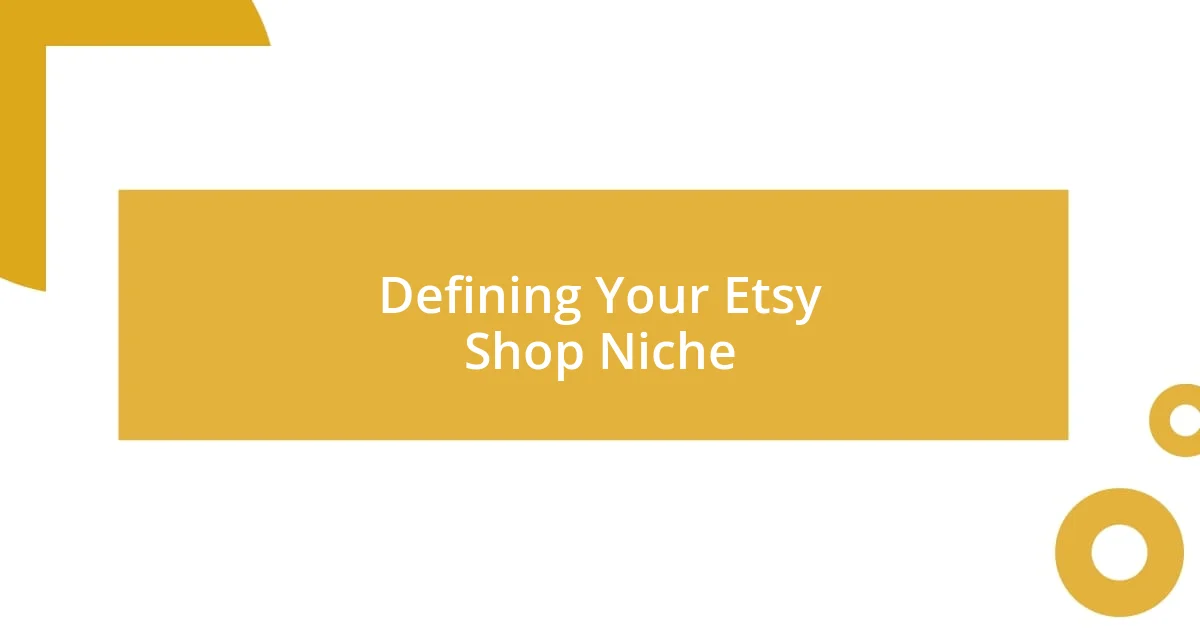
Defining Your Etsy Shop Niche
Finding your niche on Etsy is more than just a buzzword; it’s like discovering a hidden treasure within the vast marketplace. When I first started out, I spent countless hours sifting through what I loved creating and what potential buyers might actually want. Have you ever felt stuck trying to decide which direction to take? That’s the moment when I realized that my unique designs were at the intersection of my passions and what customers were actively seeking.
Identifying your niche requires both introspection and a bit of research. One of the best decisions I made was to analyze existing shops in my category. I noticed what resonated with customers and what was missing from their offerings. This insight not only guided my product creation but also helped me define my shop’s voice. What do you want to convey through your work? When I found my unique angle, it felt like unlocking a door to endless creative possibilities.
Don’t be afraid to get a little personal with your niche. I remember sharing a piece that reflected my journey, which surprisingly resonated with many buyers. It taught me the importance of authenticity. When you embed your story into your products, it creates a connection with shoppers that can truly set your shop apart. What moments in your life can inspire your creations?
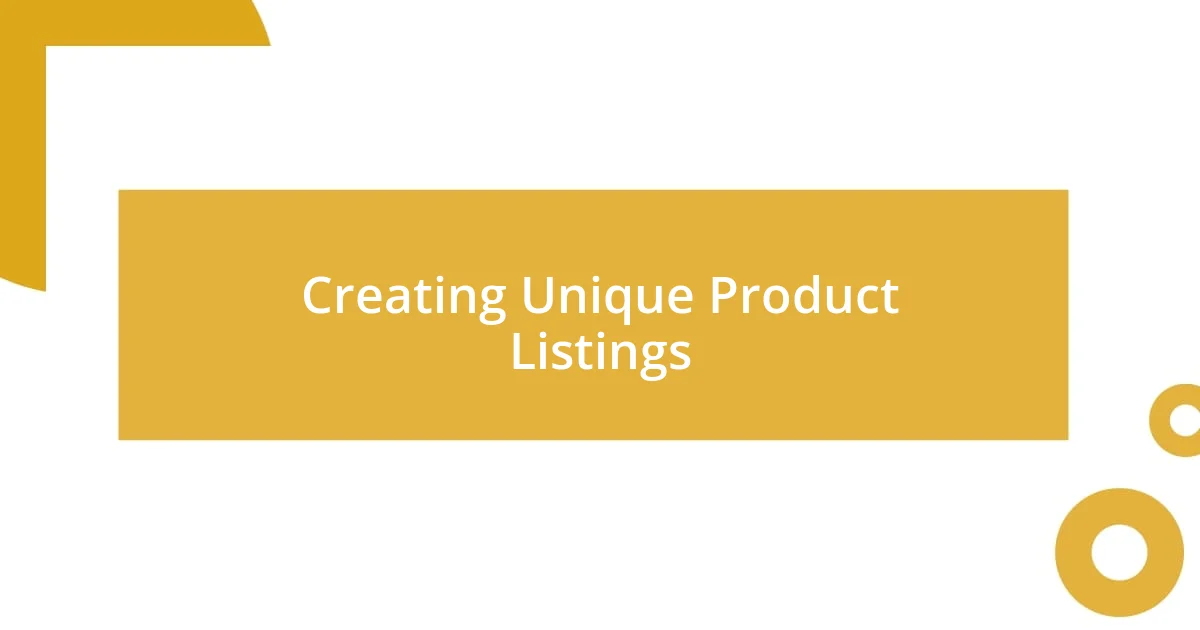
Creating Unique Product Listings
Creating unique product listings is all about storytelling and visual appeal. When I crafted my first listings, I learned quickly that great photos can make or break a sale. I recall spending an entire afternoon experimenting with different lighting and backdrops for one product. The results changed everything—those photos highlighted the intricacies of my work and drew in customers better than any words could. A strong visual can evoke emotions and spark a connection, and that’s something I’ve kept at the forefront of my strategy.
To make your listings stand out, consider these key elements:
- High-Quality Images: Use natural light and appealing backgrounds to showcase your products.
- Compelling Titles: Incorporate relevant keywords without sacrificing creativity; make them catchy.
- Detailed Descriptions: Share your story and explain how the product can enhance the buyer’s life or solve a problem.
- Personal Touch: Include anecdotes or the inspiration behind the product to create a connection.
- SEO Optimization: Use relevant tags and strategic keywords to improve visibility in Etsy’s search results.
By focusing on these aspects, you’ll create listings that not only stand out but also resonate with your audience on a deeper level.
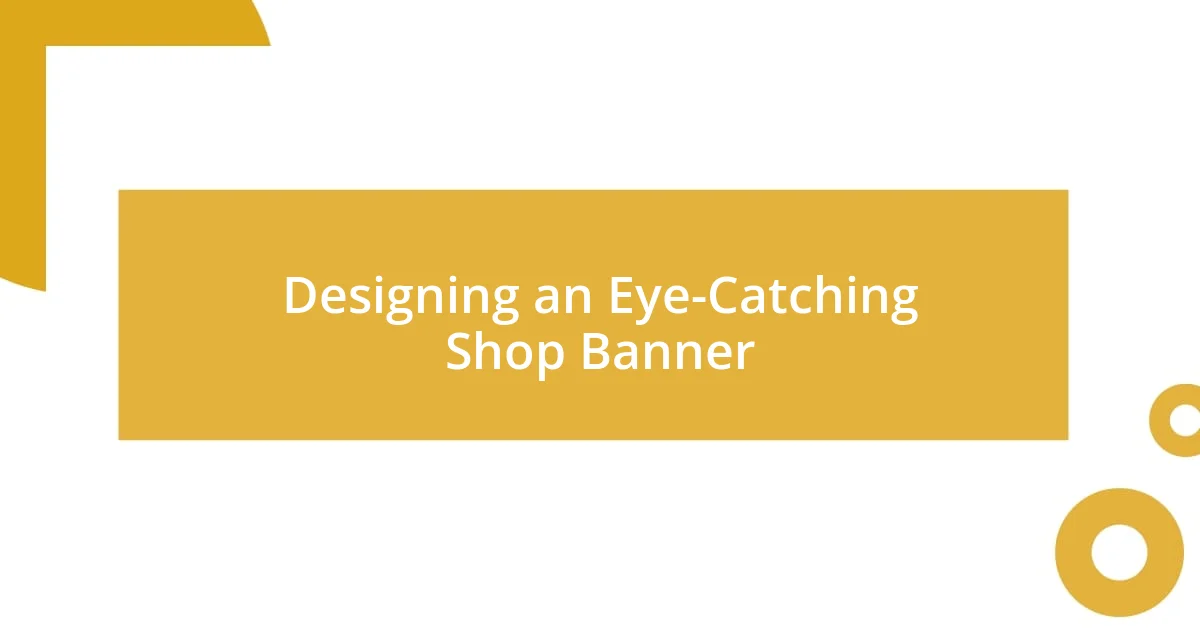
Designing an Eye-Catching Shop Banner
Designing an eye-catching shop banner is crucial for making a lasting first impression. I remember when I first created mine; I wanted it to reflect my brand’s personality. After experimenting with colors and fonts for days, I finally hit the right balance. Seeing that banner up made my shop feel complete, like I was inviting customers into my creative space.
The banner isn’t just a decorative element; it’s a visual representation of your brand. I learned this the hard way when I initially used a generic template. It didn’t capture the essence of my work, and I could feel that disconnect with my audience. When I redesigned it to include my signature style and colors, I noticed a significant uptick in visits. A well-designed banner can convey your story at a glance and draw people in.
Let’s not forget the importance of clarity. While it’s tempting to fill your banner with intricate designs, simplicity often speaks volumes. I chose to feature a clean layout with bold text that clearly stated what I offered. This approach allowed potential customers to quickly grasp what my shop was about. Remember, your banner is the storefront of your online presence, and it should invite customers in.
| Aspect | Consideration |
|---|---|
| Colors | Choose colors that reflect your brand identity and evoke the right emotions. |
| Fonts | Use fonts that are easy to read and match the aesthetic of your products. |
| Imagery | Incorporate images that showcase your products or brand vibe. |
| Simplicity | A clean design often attracts more attention than a cluttered one. |
| Brand Message | Make sure your banner communicates your unique selling proposition clearly. |
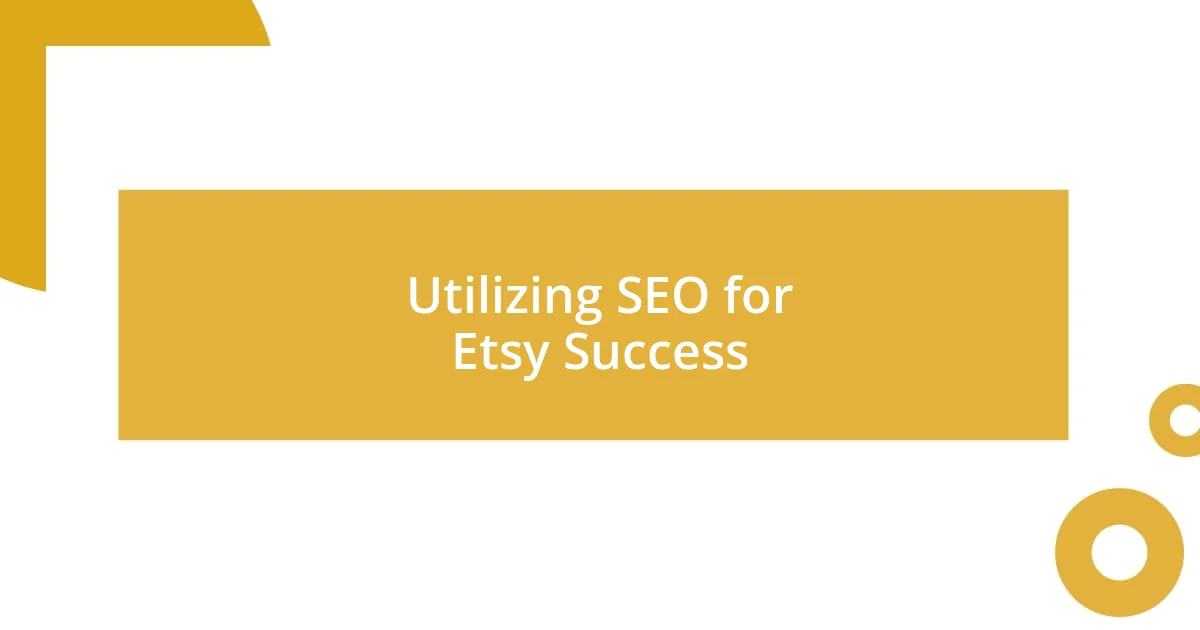
Utilizing SEO for Etsy Success
Utilizing SEO for Etsy success is a game-changer. When I first started, I didn’t grasp just how vital keywords were to my visibility. After some careful research, I realized that using specific phrases my potential customers were searching for dramatically improved my shop’s traffic. It felt almost magical watching my views multiply simply by tweaking titles and tags to reflect what people wanted.
As I continued to refine my approach, I learned how to strike a balance between creativity and keyword usage. It was tempting to focus solely on SEO tricks, but I found that genuine storytelling in my product descriptions made a real difference. For example, when I shared the inspiration behind a handmade necklace, it not only drew in viewers but also made them feel an emotional connection. That connection translated into sales—a powerful reminder that honesty resonates deeply.
I often ask myself, “What do my customers really want?” This reflective practice led me to include relevant tags and categories that aligned with their interests. I was surprised to discover that researching competitors gave me fresh ideas on how to enhance my own listings. By simply taking a moment to step into my customer’s shoes, I discovered what they were looking for, and that insight shaped my entire SEO strategy.
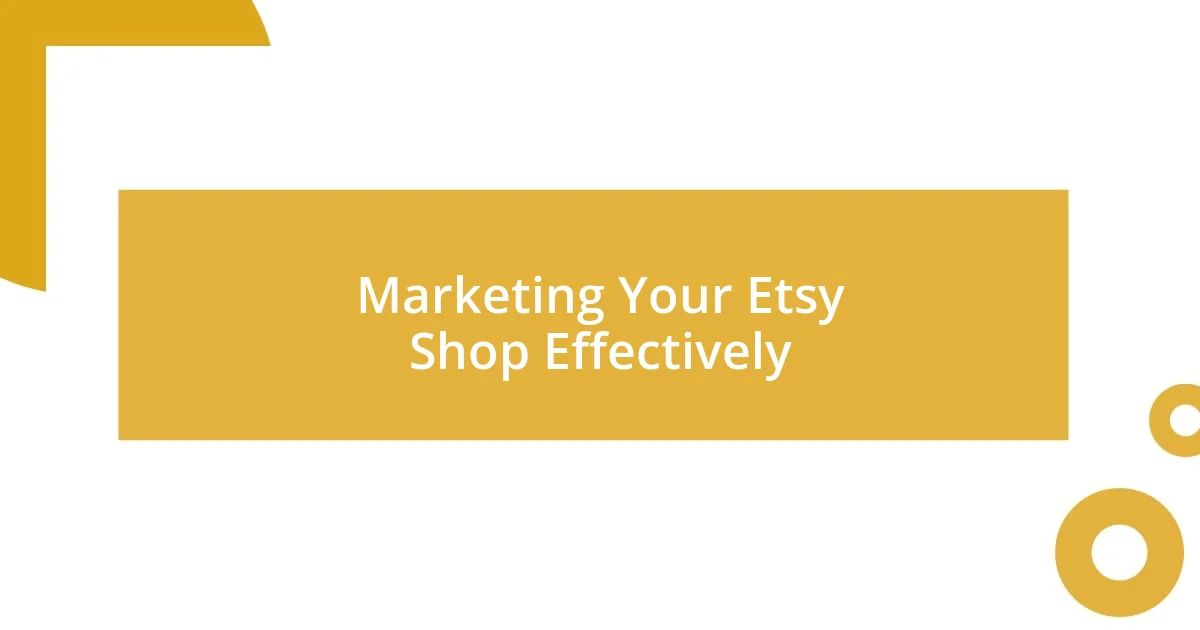
Marketing Your Etsy Shop Effectively
Marketing your Etsy shop effectively often hinges on building relationships with your customers. I vividly remember participating in a local craft fair, where I genuinely connected with potential buyers. That experience taught me the value of engaging with my audience beyond the screen. I later started sending personalized thank-you notes with every order. This small gesture not only delighted my customers but created loyal fans who returned to shop again.
Social media has been another incredible tool in my marketing toolbox. I still recall the excitement of my first Instagram post showcasing a new product. I used relevant hashtags and interacted with other creators, and before I knew it, I was receiving inquiries from people who discovered my shop through those interactions. It reinforced my belief that being active on social platforms can significantly increase visibility and foster a sense of community around your brand.
Have you ever considered the power of collaboration? I realized early on that teaming up with fellow Etsy sellers for joint promotions could amplify our reach. I partnered with a leather goods maker for a giveaway, and we both saw a surge in followers and sales. Clearly communicating our shared values and aesthetics helped our brands resonate with each other’s audiences, proving that collaboration can be a win-win for everyone involved.

Managing Customer Relationships
Building strong customer relationships is essential in any business, and that has been a cornerstone of my Etsy success. Early on, I learned the importance of being responsive. There was one instance when a customer had a question about customizing an order. I replied promptly and provided detailed options, which led not only to a sale but also a glowing review. That interaction reinforced the idea that timely communication could transform a simple transaction into a meaningful connection.
When I think about customer feedback, it’s fascinating how valuable their insights can be. I remember receiving a critical review that initially stung, but I took it as an opportunity to improve. I reached out to the customer for clarification and ended up incorporating their suggestion into my products. This not only improved the quality of my offerings but also showed my customers that I genuinely care about their opinions and am willing to adapt. Isn’t it incredible how something that feels negative on the surface can turn into a stepping stone for growth?
I’ve also embraced the power of follow-ups, which has truly strengthened my customer relationships. After a purchase, I send a warm email checking in to see if everything met their expectations. There was a day when a customer responded with delightful feedback, sharing how my product brought joy to her special occasion. It made me realize that these small gestures create a sense of community and loyalty. Being intentional about maintaining these connections has cultivated an atmosphere where my customers feel valued and excited to return.
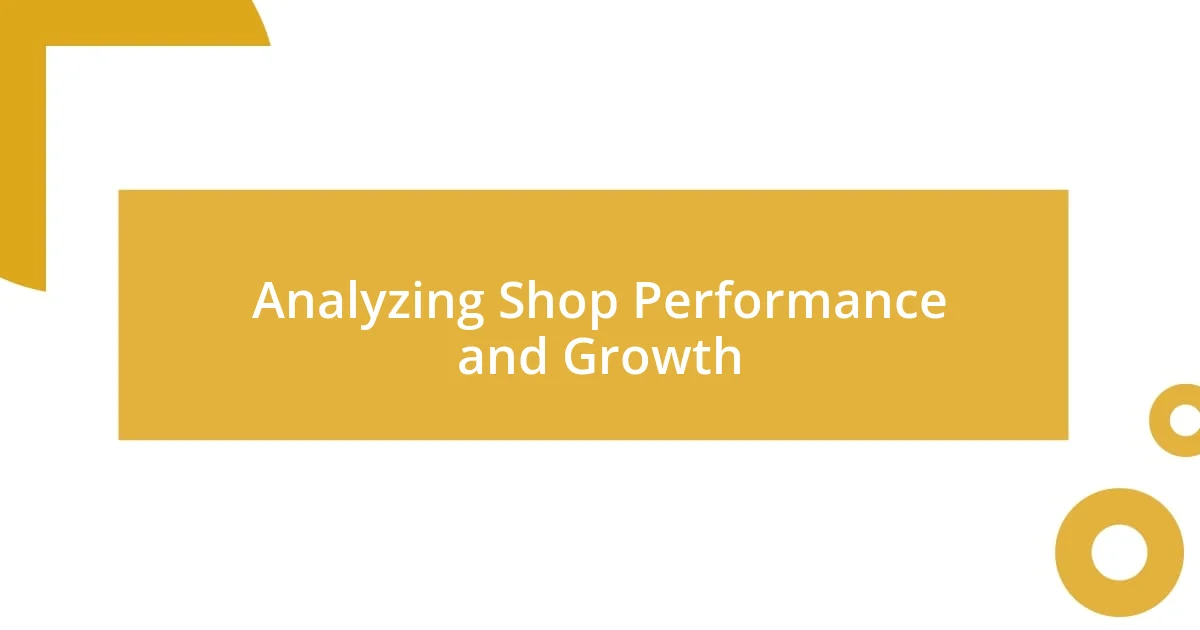
Analyzing Shop Performance and Growth
When it comes to analyzing shop performance, I often dive deep into my Etsy shop statistics. I still remember the moment I discovered the dashboard feature that breaks down sales by month, allowing me to compare trends. This insight was eye-opening! I could see what products resonated most with customers and identify seasonal peaks, which informed my inventory decisions. Have you ever thought about how this data could tell you a story about your shop’s journey? It enables sellers like me to make informed choices, ensuring growth is not just a hope but a strategy.
Looking at conversion rates has been another vital aspect of my analysis. In the early days, I noticed that some products were getting plenty of views but not converting into sales. This discrepancy nudged me to reassess my product descriptions and photography. I vividly recall re-shooting a few items with better lighting, which pivoted the sales trajectory. It’s interesting how making something visually inviting can lead to more “clicks to carts.” Have you ever wondered whether your images truly represent the quality of your products?
Moreover, I find setting specific growth goals keeps me motivated. I once aimed to increase my monthly sales by 20% within three months. Each week, I would monitor my progress, celebrating small wins along the way, whether it was gaining new followers or receiving positive feedback. This approach kept me engaged and driven. Have you tried setting measurable goals for your shop? It not only fosters accountability but also fuels a sense of achievement as you watch your efforts translate into tangible growth.















